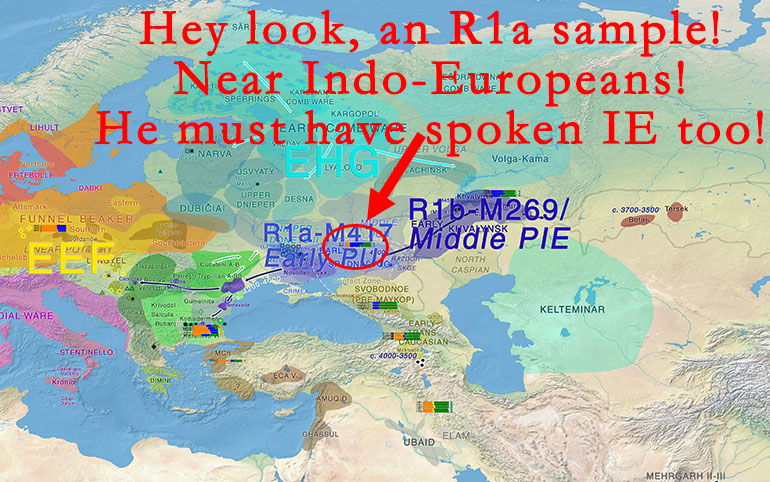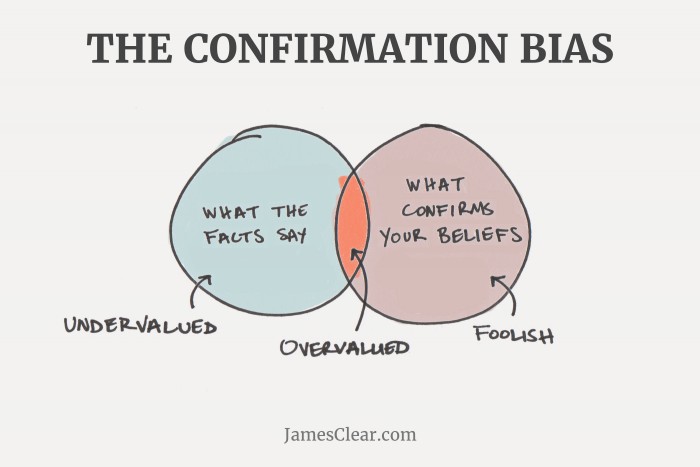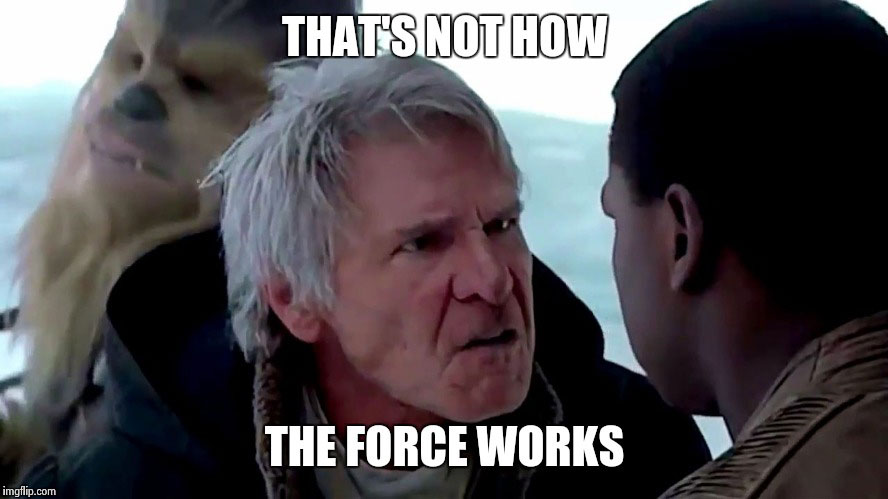This is a series of posts I wrote at the end of 2017 / beginning of 2018, to answer the wrong assumptions I could read in forums and blogs. I decided not to publish them then, seeing how many successive papers were confirming my theory in a (surprisingly) clear-cut way. Nevertheless, because I keep reading the same comments and personal attacks no matter what gets published even in mid-2018, I have decided to update and publish them. This way I will be able to respond to the “haplogroup R1a – Indo-European association” directly by pointing to any of these posts from now on, instead of writing a comment each time.
- 1. Haplogroup is not language, but R1b-L23 expansion was associated with Proto-Indo-Europeans
- 2. The history of the simplistic ‘haplogroup R1a — Indo-European’ association
- Related post: Germanic–Balto-Slavic and Satem (‘Indo-Slavonic’) dialect revisionism by amateur geneticists, or why R1a lineages *must* have spoken Proto-Indo-European
- Related post: Aquitanians and Iberians of haplogroup R1b are exactly like Indo-Iranians and Balto-Slavs of haplogroup R1a
- 3. Tips for dialogue with those supporting the ‘haplogroup R1a — Indo-European’ association
- 4. The “Indo-European Corded Ware theory” doesn’t hold water
Addition of 2019 to this series of posts:
I recently read the book Getting to Yes, about negotiating agreements. It’s a great tool for everyday dialectics. I suggest you read it if you need to engage in difficult conversations on a daily or weekly basis.
As to why do we need to discuss these things.. Well, because they matter.
There are questions – like the Out-of-India Theory – which are merely remains of a far-fetched model in Linguistics, and an untenable position in Archaeology. Genetics cannot change that. While discussion is sometimes unavoidable – e.g. when some important media echoes this absurd model -, if you frequently engage with these people you are either an Internet troll, or you are looking for them (in my opinion, that is the wrong kind of audience and interaction).
However, there are questions, like the ‘R1a – Indo-European’ association, which are becoming a tradition, a sort of fait accompli among certain hobbyist geneticists and anthropologists, so they are important for me to clarify: firstly because we have given it too much publicity in the past (mea culpa for helping disseminate it), and secondly because it was great to realize that Genetics could boost our knowledge of Proto-Indo-European and Proto-Indo-Europeans, but it is awful that it could now get in the way of Anthropology and Archaeology, and these could in turn wrongly influence Linguistic classification.

Also, on a more personal (or pragmatic, if you want) level, I have been arguing for more European integration since 2005, through a common, quite recent language to most EU citizens, a quite confidently reconstructible North-West Indo-European – contrasting with the more theoretical Late PIE or Middle PIE reconstructions.
But how can we unite in Europe (whether with or without a common language), if people keep thinking about prehistoric peoples in terms of modern nations and languages, as if we had to relive the errors of the 20th century? How can someone pretend to join others, if they are secretly trying to make their ethnic group look superior or purer than others, be it based on the traditional skin/hair/eye colour distinctions, or nowadays on genetic history, ancestral components, or haplogroups? We are seeing the rise of populism in the U.S.A. and in Europe alike, and new genetic tools is helping this trend, when it should actually do the opposite.
For me, the ‘R1a – Indo-European’ association is clearly always in these discussions the basic pre-condition, the only premise, a dogma followed blindly by their supporters. From that starting point, other data (anthropological models of migration, then archaeological data, then linguistics) are selected to support their claims, and those against it are dismissed. In that sense, the disciplines involved in Indo-European studies are reversed, misused for the political aims of modern ethnolinguistic identification.
Common fallacies used by them involve thus petitio principii (begging the question), circulus in demonstrando (circular reasoning), inductive fallacy (making conclusions from light and faulty premises), moving the goalposts (quantity of R1a and R1b found in different cultures irrelevant as long as one is found in the desired territory), onus probandi, false authority (using whatever they find to support their premises), proof by assertion, special pleading (R1a and R1b forming separate communities, but migrating together speaking the same language albeit in separate regions for no reason)….
A false premise and many fallacies does not mean that the infinite models used to support it are all wrong because of that, indeed, but it gives you an idea of potential huge flaws and confirmation bias at play.
Ten reasons for and against the ‘R1a – Indo-European’ association
So here they are, ten potential reasons that occured to me about why R1a must be associated with Proto-Indo-European speakers, based on what I read in blogs and comments everywhere, and how to answer them, including a reference to fallacies they imply.
I. R1a brought Pre-Proto-Indo-European to the steppe, based on the formation of EHG ancestry in the Mesolithic steppe.
Circulus in demonstrando (circular reasoning), circular cause and consequence.
So, tracing back Indo-European migrations (obtained from anthropological models of migration, based on archaeological data, based on ancestral Indo-European languages’ guesstimates by linguists) we arrived to the Neolithic/Chalcolithic steppe for a Proto-Indo-European homeland. Ergo, the language ancestral to PIE was formed in the Mesolithic steppe? Also, because R1a was maybe responsible for the formation of EHG ancestry, then it was also responsible for the development of the language ancestral to PIE?
It might be true. As it might be true that it was R1b lineages, from central or south-east Europe, which brought Pre-Indo-Uralic and WHG ancestry (which might have mixed with ANE ancestry from east Eurasian migrants to form EHG ancestry) to east Europe (as we see in Botai samples). Or maybe it was peoples of haplogroup Q who brought a second wave of ANE ancestry to the steppe – and there is thus a hint for a connection among Eurasian languages -, who knows.
As I see it, right now there is no way of telling what exactly happened, and even in the Early Neolithic the situation was apparently still mixed in the steppe in terms of haplogroups, and only gradually did certain elite groups prosper – R1b-M269 in Khvalynsk, R1a-M417 possibly in Sredni Stog (probably in the Dnieper-Dniester steppe or forest-steppe zone). In any possible case, the fact that R1a might have brought Pre-Indo-Uralic from central or eastern Eurasia does not change the fact that they didn’t form the Yamna culture, ergo they didn’t develop nor expand Indo-European languages as we understand them.
II. If there is/are one/more sample/s of R1a-M417 in Yamna/Hungarian settlers/Lesser Poland/East Bell Beakers… Or one sample of R1b-L23 in Sredni Stog/Corded Ware…Then ‘R1a – Indo-European’ is right
Secundum quid (insufficient statistics / insufficient sample, lonely fact, jumping to conclusions), cherry picking.
Nope. That is predictable. As you certainly know, both communities were distant neighbours in the Pontic-Caspian steppe (R1b lineages expanding in Khvalynsk, R1a probably expanding with Sredni Stog or the nearby forest-steppe/Forest Zone), there were migrations from Khvalynsk to the Balkans through North Pontic steppe territory (and partial domination over it), and later there were contacts between Corded Ware groups and Yamna settlers/Bell Beakers.
Is that finding really unexpected in such close communities?
You were probably expecting some kind of R1a-M417 community hidden in Yamna/Bell Beaker/Afanasevo samples: did that really happen?
You were expecting steppe ancestry to show a similarly (diversely) distributed Yamna/Afanasevo/Corded Ware groups, the supposed early branches of Late PIE: did that really happen? No. Yamna (including Yamna settlers) and Afanasevo show a clearly differentiated genetic structure, and (unexpectedly) Y-DNA shows a quite homogeneous picture of R1b-L23, without a single case of R1a-Z645.
Would you accept such an example against your own models? I doubt it:
- What would (do) you say if there were samples of one/some R1a subclades in India? How would you judge when a sample in India is just one sample, and when it means a whole community and the acceptance of the Out-of-India theory?
- What would (do) you say if there is R1 in North Iran?
Enunciate some objective criteria, so that you can be held accountable to them in the future. Be prepared to apply these criteria when samples against your ideas appear.
Also, when we say that migrations are accompanied by the expansion of an ancestral component, and a reduction in haplogroup diversity (see here for many examples) did you really think we mean that the expanding subclade is the only one that can be found, and that it cannot be found in other, different cultures? Remember that any argument you use can and will be used against you in the future…
To sum up: if you were just waiting for one sample of R1a to appear, and make new rules of how to interpret it, you cannot expect your reasoning to be taken seriously. Especially by me, because I have been saying that we could find R1a samples along the way (and for the moment I have been wrong; not a single one has been found).
III. Peoples of R1a spoke Indo-European because they lived in the North Pontic steppe / steppe-forest, probably as part of the Sredni Stog culture, and they formed a close community with Yamna.
III.1. Equivocation (definitional retreat, Motte-and-bailey fallacy, etc.):
That’s another position (the newest today) of those who supported a Yamna -> Corded Ware -> Bell Beaker expansion in 2015-2016.
The most common one in 2017 since Olalde et al. (2017) and the initial version of Mathieson et al. (2017) has been a Yamna -> Corded Ware + Yamna -> Bell Beaker migration model.
What would (do) you say about J and CHG entering (or being at) the steppe with Neolithic groups of EHG ancestry and R1 subclades? Is CHG ancestry or haplogroup J to be associated with Indo-European in the steppe? No? Then why is steppe ancestry or R1 (in general) to be associated with Indo-Europeans?
As for the Indo-European Corded Ware Theory proponents (academics), a contemporaneous Yamna/Corded Ware expansion with a a long-lasting Trypillia/GAC/CWC contact and a cultural diffusion of some kind is proposed now.
So the concept of R1a/Indo-European association/migration continues to change as needed, and it is not possible to know where they stand anymore, apart from the ‘R1a – Indo-European’ meme.
III.2. Faulty/hasty generalizations, cherry picking:
Previously, Yamna was asserted to contain R1a subclades for sure, simply because of the Yamnaya ancestral component. It was, without a doubt, an R1a/R1b community.
Now, when it is clear that such a community didn’t exist, after one single find in Eneolithic Ukraine, some people are asserting that Corded Ware is derived from Sredni Stog, for sure.
That is not certain, though. We have a quite ‘late’ subclade, R1a-Z93, and the first R1a-Z282 samples popping up are from the Baltic region. We don’t have more samples to the north of Sredni Stog.
And yet, the R1a-Indo-European myth continues based on the “steppe ancestry”, an ancestral component whose origin and development is still unknown… Because, after all, it is a combination of EHG and CHG. But which EHG and which CHG components formed each group, and from which ancestral groups?
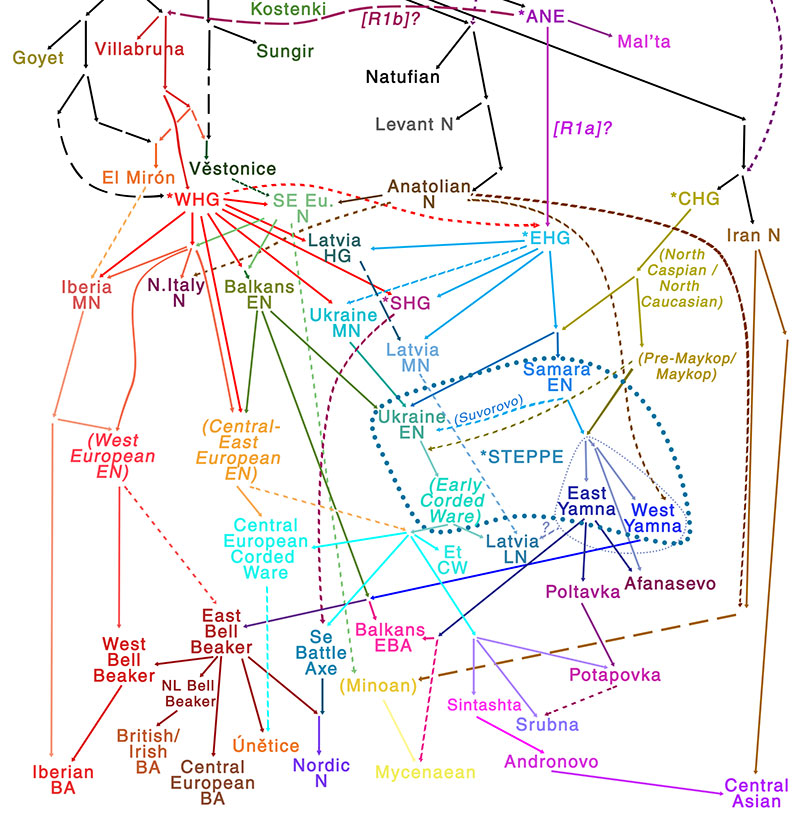
Would you argue that EEF (a combination of WHG + Anatolia N) is representative of a single people and a language? Without taking into account the culture, amount and timing of arrival of each component, the geography, and the phylogeography? So, all Neolithic languages (say, the hypothetic Tyrrhenian group, Palaeo-Sardo, Minoan, Eteocretan, or even Iberian or Vasconic, and the supposed Funnelbeaker-Semitic from Kroonen, all were the same language from Neolithic to Bronze Age, and all descended from Anatolia Neolithic ancestry?
It does not make any sense. And similarly, any combination of steppe ancestry (EHG+CHG) does not mean Indo-European. That is simply not serious.
III.3. Definist fallacy (we don’t know what is being defined and how, or why):
Because R1a-M417 has been found in the Eneolithic North Pontic steppe, the concept is now changing again, to a Sredni Stog -> Corded Ware + Yamna -> Bell Beaker, whereby all steppe cultures were Proto-Indo-European-speaking.
Just like that, based solely on the poorly defined “steppe ancestry” and on R1a-M417 finds, we now have to talk about an immutable mythical steppe people speaking a steppe language for thousands of years.
Sure, some people of haplogroup R1a lived in the steppe. As were R1b-V88, or I2 lineages. The problem is, there is a tiny little 2,000-year gap between the Late Indo-European-speaking Yamna culture (from which all known living IE languages derived), ca. 3300 BC, and the proposed connection of the preceding Khvalynsk culture within a potential cultural-historical community of steppe cultures (including Sredni Stog), ca. 5000 BC or earlier.
As you know, Indo-European studies is first and foremost about Proto-Indo-European reconstruction (Linguistics), then about where it could have spread culturally (Archaeology, Anthropology), and then about ascertaining if migrations actually happened (Genetics), or it was a mere diffusion of culture. It’s not the other way round: “R1a spoke Indo-European, ergo Sredni Stog must have spoken Proto-Indo-European”; or “a Northern Caspian steppe culture with this admixture spoke Late Indo-European ca. 3000 BC, so a North Pontic steppe culture with a similar admixture N centuries/millennia before also spoke Indo-European”. That doesn’t make any sense. That is, unless you want to believe that.
If you take common proto-language guesstimates, and the existence of a close community speaking a North-West Indo-European language reconstructed ca. 2500-2000 BC, the probability to reconstruct a Late Proto-Indo-European language dated ca. 5000 BC is minimal. If Indo-Iranian is dated ca. 2000 BC, even a hypothetic and controversial Indo-Slavonic group cannot be dated much earlier, since Graeco-Aryan (judging by haplogroups and admixture in the Balkans, and the dating of Proto-Greek ca. 2000 BC) must have come from the steppe, probably no earlier than 3500-3000 BC.
Also, the spread of the most archaic Indo-European family (the first to branch off), Anatolian, is supposed to have accompanied the expansion of Suvorovo-Novodanilovka chiefs after ca. 4400 BC into the North Pontic steppe and the Balkans, which leaves a common language dated earlier than 5000 BC beyond the reconstructible Proto-Indo-European (i.e. Indo-Hittite or Middle Proto-Indo-European), and into the limits of internal reconstruction i.e. Early Proto-Indo-European, or potentially (as currently favoured by the Leiden School) Indo-Uralic.
As to the possibility of an Indo-Hittite dialect spread with Corded Ware, it is indeed a better option than a Late Indo-European dialect, but it seems to pose more questions than it answers, about the fate of this branch among Corded Ware groups as they expanded throughout Europe and Asia… Whereas the identification of CWC peoples with Uralic speakers is compatible with the survival of branches of the language in North-Eastern Europe.
III.4. Ad ignorantiam (argument from ignorance):
Whenever I read or hear the words “cultural diffusion” regarding Indo-European languages, and especially the Corded Ware culture, I think about this fallacy. On the other hand, I agree that the sole fact that it cannot be proven can’t be the only reason to dismiss it (or else it would involve the same fallacy…).
From a cultural diffusion point of view, models such as Anthony’s old IECWT / new IECWT can be supported, as can be Renfrew’s Anatolian homeland hypothesis, Gamkrelidze-Ivanov’s Armenian hypothesis, Kristiansen’s traditional model, Vander Linden’s North Pontic hypothesis, and so many others.
But I think we would all agree that cultural diffusion (especially one involving language transmission, which is one of the strongest ethnic connections among humans) needs much more data to support it than the old simple anthropological migration wave based on archaeological data…
IV. R1a is today (was in the recent past) associated with some Germanic and Balto-Slavic peoples, and with the steppe and steppe ancestry. Other haplogroups are (were) not.
Post hoc ergo propter hoc (correlation/association proves causation), affirming the consequent, McNamara fallacy, Texas sharpshooter fallacy, and ignoratio elenchi (irrelevant conclusion, missing the point)
Yes. And Mycenaeans, Old Hittites, Iberian Bell Beakers, and some Indo-Iranian groups had a tiny (or absolutely no) share of steppe ancestry, and western Iberians, Greeks, Anatolians, Illyrians, Southern Italians, or Iranians have a majority of non-steppe-related haplogroups. But the oldest-attested Late Indo-European languages were attested precisely in these regions, and a lot of modern people with steppe ancestry and steppe-related haplogroups today from Estonia, Finland, Hungary, or Bashkortostan don’t speak Indo-European.
What’s the point of using modern phylogeography or statistical tools for ancestral languages? Haven’t we learned anything from Cavalli-Sforza and the 1990s yet?
V. People supporting the opposite theory were/are wrong asserting X… So they were/are wrong on the whole theory
There are three possibilities here.
V.1. X was/is not asserted: straw man fallacy, false attribution, quoting out of context, and especially beware of red herring.
First, be sure that X is actually claimed exactly like that in the theory, and has not been added / misinterpreted by the source you read it from. Because, as you can imagine, you don’t get to redefine a model, and then claim that it is wrong.
V.2. X was/is asserted, and is not wrong: ad lapidem (appeal to the stone).
Check the facts to see if it is actually wrong, or maybe you are trusting your indirect source when you clearly shouldn’t.
V.3. X was/is asserted and is clearly wrong: Ad logicam (fallacy fallacy).
You can be wrong again and again in details, and the theory be mostly right, like Gimbutas’ steppe model, for example, which is still right in essence, but wrong in so many details.
Being a scientist means never having to say you are certain about anything, or – as Richard Feynman would say – “The statements of science are not of what is true and what is not true, but statements of what is known with different degrees of certainty”.
You can also make minor changes to your theory, like Anthony or Heyd have done since 2007, to keep up with the facts, while maintaining your basic breakthrough premises intact.
Think that those supporting ‘R1a – Indo-European association’ have been constantly changing models to fit their desires, and have thus engaged into infinite fallacies along the way. Did that change your position regarding the truth of the association? I am constantly trying to assert that it is absurd to change positions to fit such a dumb premise, but nevertheless I accept changes and continue to challenge them, trying not to invoke too much the tu quoque (“you too”, appeal to hypocrisy). Now, if you want to use that fallacist’s fallacy as an argument for any other theory, you should apply it first to your preferred one, i.e. the association ‘R1a – Indo-European’, which should have then stopped to be mentioned at all a long time ago (see above question III)…
VI. People supporting an opposite theory were/are wrong asserting X… So they were/are stupid and therefore unreliable
Ad hominem, ad baculum (appeal to threat, try to oust the competition, turn a civilised discussion into a bar brawl).
There is a quite common trend among amateur geneticists of insulting people for being (potentially) wrong, and names of prestigious and accomplished linguists and archaeologists are constantly dragged through the mud in certain forums. That is probably the only tool for those without any culture whatsoever, as it is simply copied from a common belief akin to Forrest Gump’s “stupid is as stupid does” – which is stupid in itself, if you didn’t catch that part from the film.
Those who are wrong are not stupid (or else we all are). That sort of reasoning in life, and especially in Science, is plainly wrong. It is the typical argument of people who have never published anything, and don’t intend to. They can thus never be ‘wrong/stupid’, because they don’t support anything publicly, in peer-reviewed papers (or otherwise)…
That argument has not been very common in academic or scientific writings, although it is a general trend for those of us who publish to respond to legitimate scientific criticism in an angry, defensive, closed, non-scientific way. Nevertheless, modern genetic fortune tellers (amateur geneticists), who deify the new playboys in Academia, accompany them as a sort of bad boys, bullies who feel superior playing with numbers and algorithms in their computers, trying to troll and shame others in public to turn the attention away from actual data.
I cannot stop thinking to myself What are you, five? constantly when reading their shitty comments. Nevertheless, this is apparently how this stupid pride battle is fought, with contempt and bad forms, so I don’t flee from it, and I reluctantly participate in it. In fact, I dare say there is some kind of market out there where everyone involved in discussions of the lowest levels obtains some kind of personal satisfaction, creating a sort of fight clubs all over the Internet.
And I consciously wrote “accompany” because, even if not encouraging them directly, it would seem that some professional geneticists are actively communicating and participating with these fight dogs willingly, and are thus content with having them around, creating a sort of tacit good cop/bad cop arrangement, which is disturbing to say the least. In that symbiosis, geneticists don’t need to get their hands dirty (and thus don’t need to discuss anything among academics), and amateurs obtain in exchange some first-hand information and counseling.
They might not realize that such amateur geneticist – actually haplogroup/ethnic fanboys with obvious political and ethnic agendas – are not only giving publicity to otherwise ‘boring’ genetic papers, but are also representing Genomics for the general population, as they do for its use in Academia, and for the future of genetic testing and their businesses.
Everything is public today, instantly. So such mentally unstable people should be ousted from one’s own circle of connections (ignoring them would suffice), officially and ASAP, or else one (or one’s research group) could end up being in turn bullied on the Internet by those supporting the people insulted. Or, still worst, some geneticists could end up ousted from the university / scientific community because of the promotion of such behaviour as accomplices (bringing a growing risk of litigation and shame for their institutions or journals)…
You certainly know that traditional and simple Internet rule, and – as for Gremlins – rules are there for a reason, so just follow it: don’t feed the trolls.
VII. Y is a racist, supremacist, R1b-fanboy, etc.
Ad hominem (ad Hitlerum), genetic fallacy, judgemental language, etc. And most especially, bulverism.
Well, firstly that’s probably not true; and secondly, I don’t think that any of these would be a reason for being wrong.
Also, this argument used against me is paradoxical, since this blog began because I was especially concerned about the R1a/Indo-European association (as I was about the R1b/Vasconic for Basques, N1c/Uralic for Finns, and J/CHG/Indo-European for Iranians/Greeks) – because I believe many of these theories are entirely based on the simplistic assumption that one’s (or the own country’s majority) direct paternal forefather must be related to their modern ethnolinguistic identification. This not only brings about growing Chauvinism; it is accompanied by supremacist ideas and xenophobia.
Also, I am quite sure that – being probably an R1a/IE-fanboy of Northern or Eastern European descent yourself – you have engaged Out-of-India Theory fanboys before, insulting you in more or less the same way (Eurocentric, white supremacist, etc.). What did you tell them? Whatever it is you said (and however politely or not you said it), apply your own reasoning against them to you now.
Did you enjoy being a self-righteous, condescending commenter against Indian nationalist bigot R1a-fanboys who you knew could not be right based on genetic finds? Well, now your day of reckoning has come, and you will certainly manage the same situation more reasonably than them…
VIII. Can we find a middle term? Like, maybe Yamna and Corded Ware both spoke Late Indo-European (“it’s the steppe!”), or maybe some Corded Ware cultures spoke some ancient Indo-European dialect, or maybe …
Ad temperantiam (argument to moderation, false compromise, middle ground, fallacy of the mean).
I don’t know, can we? If Anthony’s new theory proves right in genetics (R1a expanding from Yamna Hungarian settlements, maybe through cultural diffusion with R1a-M417 groups from Lesser Poland), we could indeed. Or, if a community of R1a-Z645 is found in Yamna from Ukraine or in Hungarian settlements, who knows, we might be accepting soon the R1a – Indo-European association after all…
Else, I don’t think so.
I mean, if you are an R1a/IE-fanboy of Northern or Eastern European descent, I guess you encountered Indian R1a-fanboys. Did you find a sort of middle term? Like, you know, R1a derived from a middle point, Central Asia or something? An “Out-of-the-middle-between-East-Europe-and-India” kind of theory that would satisfy both your extreme positions…?
I don’t think Linguistics or Archaeology work like that, so it’s almost always either one or the other, not a middle position; it’s whatever Linguistics first, then Archaeology and Anthropology, and only then maybe Genetics can tell us.
IX. The ‘best’ geneticists tell us constantly since 2015 that R1a and R1b formed a community in Yamna (or, in 2018, “in the steppe”) and spoke thus the same language, PIE. What have YOU done in genetics?
Ad verecundiam (appeal to authority), appeal to accomplishment. Also, ipse dixit (bare assertion fallacy) regarding the infamous “Yamnaya ancestry component” (in turn based on a post hoc ergo propter hoc).
The correct way to study Indo-European migrations (i.e. the migration of Indo-European-speaking peoples) is to learn ancient Indo-European languages, the methods of comparative grammar, and especially Proto-Indo-European reconstruction; then to understand archaeological data, cultures, and modes of cultural transfer; and then learn potential anthropological models of migration or cultural diffusion.
Only then is Genomics useful, to ascertain which models might be more likely than others, according to the limited data available.
Some geneticists are working with an inverted method in Indo-European studies, implying that algorithms can work over other academic disciplines, or directly without them. That mistake has been made often in the past, supported by the most popular scientific tabloids (see e.g. infamous papers in Nature or in Science), and it has not worked. Ever.
If you read all papers on human migrations based on genetics since the 2000s, you can see that their anthropological interpretations were more often wrong than right. What remains is not their discussion, not even their shortest conclusion, but merely their results, which need to be reinterpreted by new papers again and again in light of new results.
Had they taken one sound migration model and kept their interpretations within such a framework, at least those taking Heyd’s, Mallory’s, or Anthony’s models would have supported a durable paradigm.
But the ‘best’ geneticists did not do that, and invented new migration waves based on erroneous interpretations of genetic data and supported by marginal theories. They were thus never the ‘best’ academics; or scientists.
If you want answers to the Indo-European question, you need to study Indo-European disciplines. There is no shortcut for that. If you don’t like languages, and you are not ready to read academic papers, you will not fare well in Indo-European studies, no matter how much you like bioinformatics, or even anthropological models of migration with their cute maps and imaginary arrows of migration. And if you take anthropological models of migration from archaeologists who don’t care about linguistics, well, you can guess the end result…
X. I am sad/angry that R1a did not spread Indo-European languages, or that R1a lineages spoke Uralic languages. That means we are ‘inferior to population X’
(This is obviously not said out loud, but this inferiority complex is the only obvious reason I can find behind all the whyning and the hatred involved with this question)
Appeal to consequences, appeal to emotion, and essentially false dilemma.
That does not make any sense. Especially in light of the closely related history of both haplogroups (linguistically, culturally, genetically) in the Mesolithic and Neolithic steppe and later in Europe.
First of all, the simplistic R1a/IE identification of the past concerned GAC-CWC – probably to connect Polish territory, which hosts a high percentage of hg R1a, to an idealised ancient picture. Then it was Yamna -> Corded Ware. Now it is Sredni Stog -> Corded Ware in a supposed millennia-long linguistic community. And so on and on it goes. As you can see, the current mainstream linguistic-archaeological model only presupposes that Late Khvalynsk and Yamna spread Indo-European languages – probably along mainly with expanding R1b-L23 subclades (according to the Indo-European demic diffusion model).
Then only after ca. 2500 BC Bronze Age European communities of Pre-Balto-Slavic speakers and North Caspian steppe communities of Pre-Indo-Iranian speakers developed, where haplogroup R1a probably became the majority. Such complex processes of cultural diffusion / founder effects are not different than the complex processes assumed for the development of Greek– or Palaeo-Balkan-speaking communities, or for Pre-Germanic-, Celtic-, or Italic and Latin-speaking communities.
So where is the drama being sold here by some interested parties? Is the expansion of Indo-Slavonic first with Corded Ware, and then of Balto-Slavic from the steppe (Srubna -> Cimmerians -> Chernoles or whatever other speculative historical path) ‘better’ for Slavs or Balts, and in what sense? Actually, from a West Slavic/Baltic perspective, the Indo-European demic diffusion model means probably for West Slavs and Balts being at the regional (and potentially haplogroup) origin of a Balto-Slavic community, as early as the Nordic community, and earlier than Italo-Celtic communities, if you are into this kind of childish interpretations…
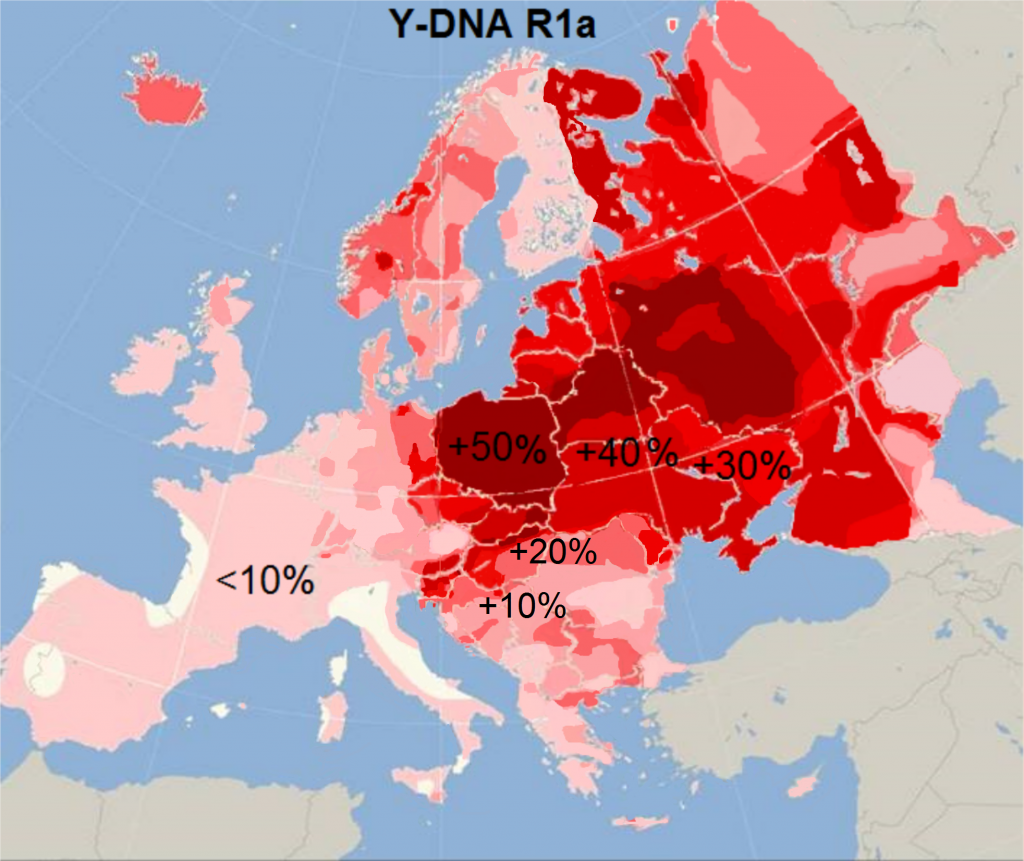
No single European culture can derive their ethnic identification or their language from a single group in the past, though. No haplogroup or ancestral component can tell you where you belong, or the ethnicity or language of your genealogical or genetic ancestors. They serve to investigate the past, not your personal (or your country’s) past!
In fact, we are all quite closely connected, more than what certain today overused bioinformatic tools might imply.
Genetic testing is fun, it is interesting from a social point of view, but don’t let their ethnicity-percentages-bait lure you into the dark side of this field, politically- or ethnically-motivated, which entails nothing more than chauvinist, supremacist, or directly racist views.
You wanted a simplistic, ideal image of the world that somehow placed you and ‘your people’ (whatever that means to you) at the top of an imaginary ethnic, cultural, or genetic pyramid, and it didn’t happen. Life goes on. Humans are able to adapt, so do you. And if you leave that supremacist view of peoples and cultures, and take history with an open curiosity, I am sure you will be far better off.
Wrap-up
So, the main issue that I have with this kind of reasoning (autochthonous continuity crap), as you can see, is not the fact that people identify the most common modern haplogroup of their region / country / ethnic group with that of their ancestors, whether 500 or 4,000 years ago, although this does not make any sense either. After all, our whole list of genealogical and genetic ancestors are not as simplistic as some would want them to be, and their meaning to our current ethnolinguistic identificaton is minimal.
Just try to discuss the Indo-European demic diffusion model with a similarly-minded (i.e. supporter of an autochthonous continuity theory) Turkish, Bashkir, or Basque speaker of haplogroup R1b, or Uralic-speaker of haplogroup N1c, to see that their reaction will be quite similar to the reaction of R1a fans, leaving their essential premise intact in any case. So, in the end, none of them can be taken seriously.
The main issue at stake here is a theoretical one, and concerns the real benefits (and correct way) of using Genomics: we deal with Indo-European studies. This discipline involves many subfields, and the traditional order of methods used departs from Linguistics (comparative grammar, historical linguistics, dialectology), then uses Archaeology (descriptive, historical, proto- and prehistorical archaeology), then Anthropology (ethnology, ethnolinguistics, ethnoarchaeology), and only then could we make use of Genetics (genomics, human evolutionary biology, phylogeography).
In the most famous recent genetic research papers, this evident traditional method has often been inverted for no reason whatsoever, creating an obvious circular reasoning where cause and consequence for migrations, peoples, or proto-languages (and their precise definition) are confused, and premises for each study are not clear anymore. You can read a recent summary of such flaws.
Finally, an advice for the most credulous: beware of genetic testing, and especially those who are profiting from it by selling simplistic ethnicity interpretations. Trusting those who sell you dreams (e.g. “your haplogroup is better“, “you have N% steppe ancestry”, “you cluster closely with these ancient tall blond Aryan conquerors”) is like trusting healing crystals or homeopathy. This applies to R1a-Indo-European, as it applies to R1b-Indo-European, or any other modern haplogroup or ancestral component linked with modern ethnolinguistic groups.
Deep inside, you know that they are wrong, so stop enabling yourself, and stop enabling them. Just study Indo-European disciplines (or whatever other language, culture, or people you are interested in) for the sake of it, or change hobbies altogether, and help thus stop this shameful corruption of academic fields you are currently part of.
If you have more related reasons or questions, please let me know. I will add them here.
